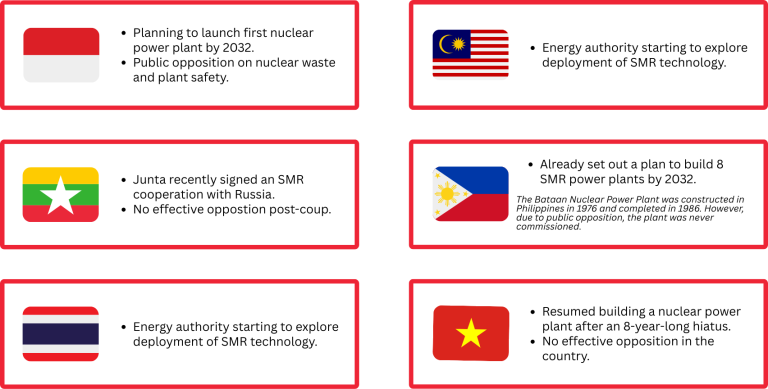While nuclear energy is not in the mix of election issues currently focused on the high cost of living, as Singapore goes to the polls, electing a multiparty parliament is important to oversight its consideration.
But is nuclear energy even an issue in Singapore? While not in the forefront, for over a decade, there have been movements in the form of feasibility studies, to include nuclear energy as a complement to existing energy sources.

In February 2025, the Energy Market Authority (EMA), a statutory board under the Ministry of Trade and Industry, released a tendering notice to study the feasibility of various nuclear reactor models and their potential to address Singapore’s future energy needs.
EMA’s move comes at a time when traditional energy sources feeding Singapore are becoming more prone to geopolitical tensions, particularly as demand for energy continues to grow. EMA has projected that by 2029, Singapore’s existing generation capacity will no longer be sufficient to meet the rising demand. Furthermore, with limited domestic energy resources, Singapore has been heavily reliant on imported natural gas, a dependence that exposes it to supply disruptions and price volatility.
Earlier in 2024, Singapore signed an agreement with the US government that set out the broad terms of nuclear cooperation between the two countries. The agreement covers pathways to cooperate on the export of nuclear material and equipment from the US, technology transfer and capacity-building.
These nuclear energy-related developments are not new.
In 2012, the Ministry of Trade and Industry conducted a pre-feasibility study on available nuclear technology but ultimately decided that nuclear energy was not suitable for deployment. The study involved several government agencies, external consultants and advisers. A factsheet accompanying the study gave no indications that the study included any wide public consultation.
While nuclear energy as an alternative energy source has always been a reluctant consideration for many countries, the idea has gained renewed attention with advancements in nuclear technologies. Small Modular Reactors (SMRs) – compact, potentially safer reactors are increasingly seen as a viable alternative to conventional nuclear power plants.

With EMA’s renewed focus on nuclear energy, Singapore joins a list of Southeast Asian countries exploring SMR technology, including Indonesia, Malaysia, Myanmar, the Philippines, Vietnam, and Thailand.
In Indonesia, the government is planning to launch its first nuclear power plant by 2032, despite public opposition on issues related to nuclear waste and the safety of the plants themselves in the earthquake-prone country.
The Philippines government has already set out a plan to build 8 SMR power plants by 2032, with no major public opposition, while the legislature seeks for safety and accountability measures. In the past, a nuclear power plant – the Bataan Nuclear Power Plant – was constructed in 1976 and completed in 1986. However, due to public opposition, the plant was never commissioned.
In the absence of any effective opposition voices, Vietnam has resumed building a nuclear power plant after an 8-year-long hiatus. Similarly, in Myanmar, the military junta has recently signed an SMR cooperation with Russia.
In Malaysia and Thailand, the respective energy authorities have started to explore the deployment of SMR technology, although this has not yet been prioritised by the government, nor have there been any substantial parliamentary and public discussions.
In terms of awareness, the commissioning of nuclear energy feasibility studies have not penetrated deeply into the public psyche nor garnered attention in Singapore. Similarly, civil society groups focused on environmental rights and climate change have not mainstreamed this issue in their advocacy campaigns.
In Parliament, there have been only a few questions directed at the government over the years.
For instance, in 2012, PAP MP Lee Bee Wah sought an update on the pre-feasibility study conducted by EMA. At the time, S. Iswaran, the Second Minister for Trade and Industry, provided a response along with a fact sheet that only broadly summarised the results of the study.
In November 2024, opposition MP Louis Chua, asked whether the government planned to conduct another pre-feasibility study on nuclear energy. The government denied such plans, despite the EMA announcing just three months after that they were seeking a consultant to undertake a study.
That same month, opposition MP Dennis Tan asked Minister for Foreign Affairs Vivian Balakrishnan whether the agreement signed with the US restricts Singapore from cooperating on nuclear energy with other countries. The Minister responded, “no”.
These questions in parliament have only addressed basic clarifications and have not explored the deeper, more complex issues surrounding nuclear energy, such as its potential risks and benefits or the broader implications for Singapore’s energy strategy and climate goals.

Meanwhile, the EMA is seeking another round of feasibility assessments from experts.
Given this momentum, it is important to bring the nuclear energy discussion to the forefront. This is to ensure that the feasibility of using nuclear energy, which has safety and waste management concerns, is robustly scrutinised in the public domain and vigorously debated by a multiparty parliament.
As Singapore goes to the polls, with the cost of living issue as a top issue, electing a multiparty parliament can at the same time ensure that any decision made around nuclear energy considers all aspects of safety and broader societal concerns.